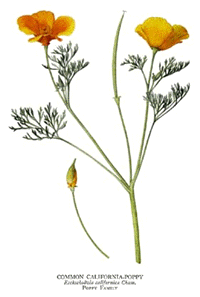|
|
|
California Poppy 
(Eschscholtzia californica or E. mexicana)
Papaveraceae family
by Natalie Pastor
They are thought to be the same flower. Some commons names
are desert gold poppy, Amapola Amarilla, Mexican gold poppy, This
flower was named the California state flower in 1903, winning
out over the Matilija poppy and the mariposa lily. California
Poppy Day is celebrated on April 6th of each year and 1998 marks
the 95th anniversary of the golden California Poppy day.
There are many species such as E. californica ssp. californica,
E. californica ssp. mexicana, E caespitosa, E lemmonii; the Tejon
poppy (E. lemmonii ssp. kernensis) and many more. On the U. S.
Fish and Wildlife Service endangered species candidate list you
will find E. multiflora ssp. twisselmannii; E.aprocera, known
locally as Kernville Poppy; and E. rhombipetala, known as diamond-petaled
Poppy.
A perennial, this species has long grown naturally in open grasslands
from Southern California to Washington. This beautiful wildflower
is blooming all over this time of year starting as early as February
and on into May. With regular water it can bloom through September.
The cheerful four-petaled, cup shaped blossoms are 2 - 3 inches
across and range from bright yellow to gold to deep orange in
color. The foliage is a bluish gray-green and feathery, fern-like
in appearance. It is a welcome sight every spring. Lots of winter
or early spring rains will cause some desert areas to glow with
this bright flower. They prefer a dry, sandy soil and full sun
and can be found growing as high up as 6000 feet elevation. The
weather plays a major part in the color of the blooms. In the
lower elevations the flowers may be more golden than orange. As
the blooming season progresses the blooms may change from bright
orange to pale yellow.
They are perennial in most areas of the Southwest but can be grown
as annuals in the north. In mild winter areas you can sow seeds
as late as February, or again in late fall to early winter. Where
the winters are harsh, sow seeds in spring. It can tolerate temperatures
down to about 40 degrees however, and often survives mild winters.
You must sow seeds in place as they do not transplant well, their
long tap root will not allow it. They will reseed, however some
years they seem to take a long vacation and don't produce very
well. The following year they are once again prolific. They will
probably germinate within a few weeks if they receive any water
at all. If left to naturalize in dry areas they will reseed but
the following year's bloom will depend on the amount of winter
water received.
If you want to collect seed from the wild or your neighbor's poppy
patch, you must pick the seed pod while it's still green and store
them in paper bags to dry. They throw off their seed at the first
opportunity and if you wait until the pods are dry, the seed will
probably already have dispersed. Let them dry in the paper bag
and at sowing time, sow the entire contents of the bag.
As a part of your garden landscape these poppies will attract
bees and butterflies to your garden. They also offer a hot, bright
color in early spring. Because of their ability to naturalize
they can be the solution to some hillside problems, their deep
taproots can be effective against mild erosion.
To harvest for medicinal use, collect and dry the aerial parts
during blooming season. It can be hung to dry in a shady location
or break into small pieces and use your dehydrator. As a medicine,
this poppy is a mild sedative, anodyne or pain reliever, antihypertensive,
antispasmodic, diaphoretic, gallbladder alterative, hypnotic,
and nervine. It has traditionally been used for gallbladder disorders,
hyperexcitability, hypertension, insomnia, and general nervousness.
It is safe to use on older children. It was used by local Indians
for colic and is sometimes recommended by American herbalists
for gallbladder colic. Most often it is used to relieve mild pain
or anxiety at bedtime. You can make a tea by using one slightly
rounded teaspoon of the chopped aerial parts per cup of boiling
water, let steep for 10 to 15 minutes. Can safely be taken for
anxiety, insomnia, or suffering from mild aches or muscle spasms.
For adult insomnia make a tea of one-half California Poppy and
one-half Passionflower, a level teaspoon of each to every cup
of boiling water. Steep 20 minutes, add a drop of honey and drink
about 15 minutes before bed. A tincture can also me made and used
for the same problems. The usual dosage of the tincture is 1/4
to 1/2 teaspoon 3 times a day, with plenty of juice or with water
at mealtime.
It contains flavone glycosides that provide a gentle analgesic
and sedative action. Much less powerful than the Opium Poppy and
it is totally non-addictive. It can be used safely in a tea, with
or without the addition of Chamomile, for children who are having
trouble sleeping, anxious or nervous. It is also taken internally
for incontinence in children. See a herbalist for specific problems
concerning children.
There are some new varieties available, 'Red Chief" a flame-red
flower with blue/green foilage and 'Milkmaid" in soft shades
of apricot and cream. These are both available in the Shepherd's
catalog. You can call them at 860-482-3638 or write to 30 Irene
Street, Torrington, Connecticut 06790.
Copyright N. Pastor 1999